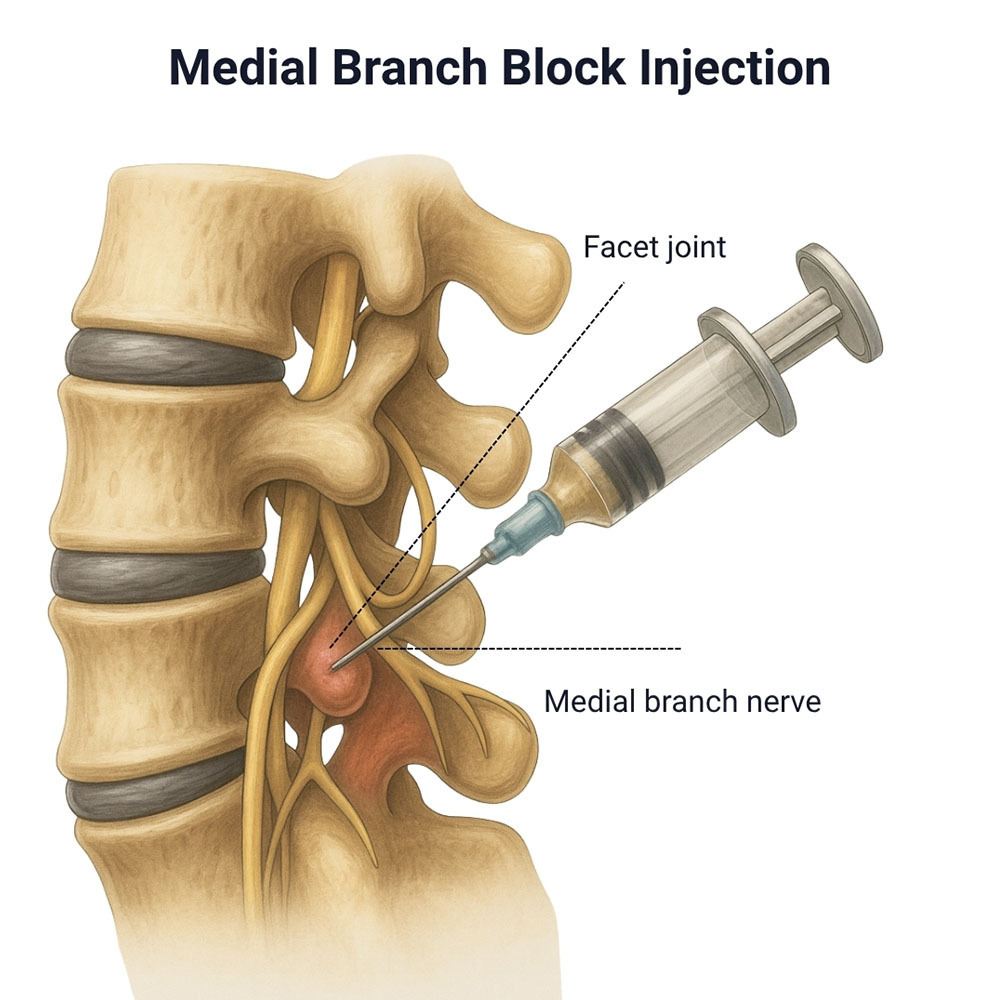 OUR LOCATIONS
Same-day Appointments Book OnlineCall to book 201.523.9590
OUR LOCATIONS
Same-day Appointments Book OnlineCall to book 201.523.9590
 OUR LOCATIONS
Same-day Appointments Book OnlineCall to book 201.523.9590
OUR LOCATIONS
Same-day Appointments Book OnlineCall to book 201.523.9590
Table of contents
 A medial branch block is an injection given into your back near the facet joints of your spine. A local anesthetic incorporated into the injection alleviates pain. The injection is very carefully placed by a doctor in your back, near the nerves that surround the affected facet joint. Your brain receives pain messages from these nerves. The injection will reduce pain and momentarily block the impulses. Your physician will make sure the injection is administered precisely through the use of X-ray guidance.
A medial branch block is an injection given into your back near the facet joints of your spine. A local anesthetic incorporated into the injection alleviates pain. The injection is very carefully placed by a doctor in your back, near the nerves that surround the affected facet joint. Your brain receives pain messages from these nerves. The injection will reduce pain and momentarily block the impulses. Your physician will make sure the injection is administered precisely through the use of X-ray guidance.
Medial branch block injections help manage chronic neck, mid-back, and lower back pain caused by several spinal conditions, including:
Our medial branch block injections at The Spine & Rehab Group allow our NJ and NYC specialists to accurately pinpoint the source of pain and design a treatment plan tailored to your needs.
Medial branch block injections provide both diagnostic and therapeutic benefits for patients with chronic neck and back pain.
Key advantages include:
Dr. Mehta has been wonderful and compassionate diagnosing and treating me for my neck/headache pain. I had a cervical medial branch nerve block performed. He and the entire staff at their center in Englewood Cliffs were fantastic! Every single person there treated me, aka a big baby, with care when I opted for sedation before my procedure. From heated seats to heated blankets to smiles, it doesn’t get any better!
Donna T. ★★★★★I’ve been seeing Josephine for a recurring back issue (bulging disc). She identifies exactly where the issue is occurring and provides branch block treatment that keeps me pain free and on the go for 6-12 months at a time. Great bedside manner, service, and no wait time. I previously tried a chiropractor which provided no relief at all.
Thanks Josephine!
After your medial branch block, your doctor will closely evaluate how much pain relief you experience in the hours and days following the procedure. If the injection significantly reduces your discomfort, it confirms that the facet joints are the likely source of your pain.
The next step may include a radiofrequency ablation (RFA) procedure, which uses heat to target the same medial branch nerves and provide longer-lasting pain relief—often for six months to a year.
If pain relief is minimal or short-lived, your physician may explore other diagnostic tests or treatment options to identify the true cause of your symptoms. Follow-up appointments are essential to ensure you receive the most effective and personalized care plan.
Medial branch blocks are performed on an outpatient basis, which is very convenient for patients. The procedure, which includes both preparation and execution, usually takes about 30 minutes. This amount of time allows for careful treatment without compromising efficiency. After the procedure, patients have another 30 minutes to rest and recuperate before leaving the facility.
 Amr Hosny, MD, MBA, FASA
Book Now
Amr Hosny, MD, MBA, FASA
Book Now
 David Chu, MD, FAAPMR
Book Now
David Chu, MD, FAAPMR
Book Now
 Vivek Mehta, MD, FAAPMR
Book Now
Vivek Mehta, MD, FAAPMR
Book Now
 Deepali Gupta, MD, DABA, DABPM
Book Now
Deepali Gupta, MD, DABA, DABPM
Book Now


Medial branch blocks are typically injected into a specific spot, and a maximum of three injections should be given over the course of six months. This restriction offers the best possible compromise between the potential risks of repeated interventions and the therapeutic benefits. It is noteworthy that a lot of patients report great pain alleviation with just several injections, demonstrating the effectiveness of this treatment approach.
Throughout a lengthy period of use, median branch blocks have shown to be both safe and efficient. Most patients achieve pain alleviation within minutes of the surgery. Patients are asked to diligently monitor the extent of their discomfort in the days following the treatment in order to accurately determine the intermetatarsal joints as the source of pain. Thanks to this proactive approach, your doctor can evaluate the efficacy of treatment and take additional action as needed.
Medial branch block injections are a safe, effective, and minimally invasive solution for diagnosing and treating neck and back pain from facet joint issues. They can relieve discomfort, guide further treatments such as physical therapy, steroid injections, or radiofrequency ablation, and improve your overall quality of life. Contact The Spine & Rehab Group in New Jersey or New York City today to see if medial branch block injections are right for you and start your journey toward better spinal health.

Dr. Hosny is a distinguished physician, educator, and healthcare leader with a commitment to advancing health equity and accessibility in the rapidly evolving landscape of modern healthcare. After completing his residency at St. Luke's Roosevelt Hospital Center, affiliated with Columbia University in New York City, he pursued an Interventional Spine Fellowship at Beth Israel Deaconess Medical Center, part of Harvard Medical School in Boston, MA.
Dr. Hosny has held prominent roles in academic medicine, including serving as an Associate Clinical Professor at New York Medical College and as the Interventional Spine Fellowship Program Director. These positions reflect his dedication to mentoring the next generation of healthcare professionals and advancing the field of interventional spine care.
More About Dr. HosnyThe Spine & Rehab Group
140 NJ-17,
Paramus, NJ 07652
(212) 242-8160



